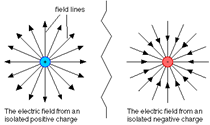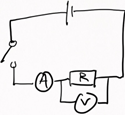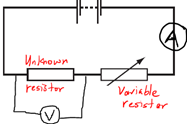
Electrical Quantities
Electric Charge
Electric charge is the physical property of matter that causes it to experience a force when placed in an electromagnetic field. The unit for charge is coulombs.
There are positive charges and negative charges. Opposite charges attract and like charges repel.

Electric Field
A region around an electric charge where another charge experiences a force is called an electric field. The field lines show the direction a positive charge would move if placed in the field.
Point charge

The field lines of a charged conducting sphere will be identical to that of a point charge (diagram above). Conducting spheres will be looked at in more detail down below.
Two parallel plates

Charging a Body
Charging a body involves the addition or removal of electrons. There are three main ways that we can charge a body
- Friction
- Conduction
- Induction
Charging by conduction will NOT be covered as it is not relevant to your course.
Charging by friction – When an object is rubbed over another object, the electrons get transferred from one object to another due to friction. The object that transfers electrons loses negative charge (electrons) and the object that accepts electrons gains negative charge (electrons).
Hence, the object that gains extra electrons becomes negatively charged and the object that loses electrons becomes positively charged. Thus, the two objects get charged by friction.
Charging by induction – The process of charging the uncharged object by bringing another charged object near to it, but not touching it, is called charging by induction.
Consider an uncharged metal sphere (positive & negative charges are equal in number) and negatively charged plastic rod as shown in below figure 1. If we bring the negatively charged plastic rod near to uncharged sphere as shown in below fig 2, charge separation occurs.

The positive charges in the sphere get attracted towards the plastic rod and move to one end of the sphere that is closer to the plastic rod. Similarly, negative charges get repelled from the plastic rod and move to another end of the sphere that is farther away from the plastic rod. Thus, the charges in the sphere rearrange themselves in a way that all the positive charges are nearer to the plastic rod and all the negative charges are farther away from it.
If this sphere is connected to a ground through the wire as shown in fig 3, free electrons of the sphere at farther end flow to the ground. Thus, the sphere becomes positively charged by induction. If the plastic rod is removed as shown in fig 4 all the positive charges spread uniformly in the sphere.
The now positively charged conducting sphere will have electric field lines similar to that of a positive point charge.
Conductors and Insulators
A conductor is something which allows electric current to flow through it freely whereas an insulator prevents any electric current flowing through it.
Conductors have free flowing electrons which allow the passage of electric current through the structure. Therefore, most metals are good conductors of electricity.
Insulators on the other hand have tightly bound electrons that are not free to move in the structure. An example of a good insulator would be rubber.
Current – Current is the rate of flow of charge.
I = Q ÷ t
[I = Current (A), Q = Charge (C), t = Time (s) ]
In metals, current is due to the flow of electrons. Although it is rather counter-intuitive, the direction of conventional current is opposite to the direction of electron flow.

Electrons flow from the negative to positive terminal. Conventional current flows from the positive to negative terminal.
In metals, current is due to the flow of electrons. Although it is rather counter-intuitive, the direction of conventional current is opposite to the direction of electron flow.
Current in a circuit can be measured with a digital or analogue ammeter.
Electromotive Force
An electrical supply (a power pack, cell or battery) provides electrical energy, which is carried round a circuit by the current. The electromotive force (e.m.f) of a supply is the energy per coulomb of charge and is measured in volts (V). A voltmeter can measure the e.m.f by connecting it parallel to the supply

The voltmeter connected parallel to the battery (on the right) will measure the e.m.f.
Potential Difference
The potential difference or voltage across a component in a circuit is the energy required per coulomb of charge to drive the current through that component. It is also measured in volts (V).

The voltmeter connected parallel to the light bulb (on the left) will measure the potential difference across the bulb.
Resistance
Background – The electrical resistance of an object is a measure of its opposition to the flow of electric current.
Metals at a constant temperature have a constant resistance, measured in ohms.
Resistance = Potential Difference ÷ Current
R = V ÷ I
The resistance of an unknown resistor can be found via an experiment and using the equation above.
Theoretically. a very simple way of finding resistance would be to set up a circuit as follows:

The ammeter in the circuit gives you the current(A). The voltmeter gives you the potential difference across the unknown resistor(V). If you put these values into the equation R=V÷I then that will give you the answer.
However, this means that we are only working with one set of readings. If we wanted to increase accuracy, we would want multiple measurements of voltage & current and therefore calculate resistance several times and average the results.
Therefore, in order to do this, we would add a variable resistor to the circuit:

A variable resistor is a resistor that has adjustable resistance. We can therefore ‘set’ the resistance to what we want it to be.
By changing the resistance of the variable resistor, the potential difference across the unknown resistor will change.
Therefore, each time we change the resistance in the variable resistor, we can apply the calculation R = V/I and attain several different calculations of resistance (which should all theoretically be very similar) and average the results afterwards.
Resistance of a Wire
The resistance of a wire depends on two main things:
- Length (of wire)
- Area (of wire)

When the length of the wire is increased, the current must travel further in the wire and thus resistance increases.
When the cross-sectional area of the wire is increased (i.e. larger wire diameter) the current has a greater area to travel through so the resistance decreases.
Electrical Working
Electrical energy is transferred from the battery or power supply in a circuit to the components in the circuit via the electrons. The components will covert the electrical energy into other forms (i.e. a lamp will convert electrical energy into light energy). The rate at which the energy is transformed is the power.
Power can be calculated from the formula below:
Power (W) = Potential Difference (V) x Current (A)
P = VI
We can also derive the formula for energy as follows:
Energy = Power x Time
Since Power = VI; Energy = V x I x t = VIt
